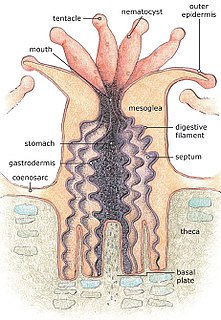
A corallite is the skeletal cup, formed by an individual stony coral polyp, in which the polyp sits and into which it can retract. The cup is composed of aragonite, a crystalline form of calcium carbonate, and is secreted by the polyp. Corallites vary in size, but in most colonial corals they are less than 3 mm (0.12 in) in diameter. The inner surface of the corallite is known as the calyx. The vertical blades inside the calyx are known as septa and in some species, these ridges continue outside the corallite wall as costae. Where there is no corallite wall, the blades are known as septocostae. The septa, costae and septocostae may have ornamentation in the form of teeth and may be thick, thin or variable in size. Sometimes there are paliform lobes, in the form of rods or blades, rising from the inner margins of the septa. These may form a neat circle called the paliform crown. The septa do not usually unite in the centre of the corallite, instead they form a columella, a tangled mass of intertwined septa, or a dome-shaped or pillar-like projection. In the living coral, the lower part of the polyp is in intimate contact with the corallite, and has radial mesenteries between the septa which increase the surface area of the body cavity and aid digestion. The septa, palliform lobes and costae can often be seen through the coenosarc, the layer of living tissue that covers the coenosteum, the part of the skeleton between the corallites.

Sea snail is a common name for slow moving marine gastropod molluscs usually with visible external shells, such as whelk or abalone. They share the taxonomic class Gastropoda with slugs, which are distinguished from snails primarily by the absence of a visible shell.

A micromollusk is a shelled mollusk which is extremely small, even at full adult size. The word is usually, but not exclusively, applied to marine mollusks, although in addition, numerous species of land snails and freshwater mollusks also reach adult size at very small dimensions.
Cymatiidae is a family of large sea snails in the superfamily Tonnoidea and the order Littorinimorpha. Members of this family are predators.

Cymatium is a genus of small to large predatory sea snails, marine gastropod mollusks in the family Cymatiidae.
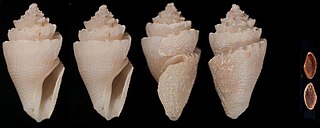
Conopleura striata is a species of sea snail, a marine gastropod mollusk in the family Drilliidae.

Ocinebrina edwardsii is a species of sea snail, a marine gastropod mollusk in the family Muricidae, the murex snails or rock snails.
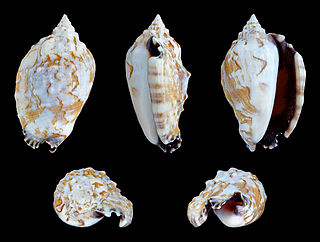
Lentigo pipus, common name : the Elegant Conch, is a species of Conch sea snail, a marine gastropod mollusk in the family Strombidae, the true conchs.

Charonia lampas is a species of predatory sea snail, a marine gastropod mollusk in the family Charoniidae.

Septa bibbeyi is a species of predatory sea snail, a marine gastropod mollusk in the family Cymatiidae.
Septa closeli is a species of predatory sea snail, a marine gastropod mollusk in the family Cymatiidae.
Septa flaveola is a species of predatory sea snail, a marine gastropod mollusk in the family Cymatiidae.
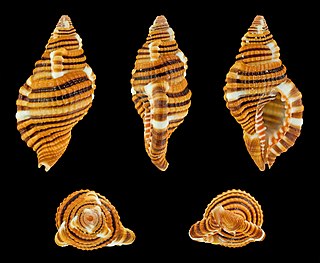
Septa hepatica is a species of predatory sea snail, a marine gastropod mollusk in the family Cymatiidae.
Septa mixta is a species of predatory sea snail, a marine gastropod mollusk in the family Cymatiidae.

Septa occidentalis is a species of predatory sea snail, a marine gastropod mollusk in the family Cymatiidae.
Septa peasei is a species of predatory sea snail, a marine gastropod mollusk in the family Cymatiidae.

Septa rubecula, common name : the ruby triton or the red redbreast triton, is a species of predatory sea snail, a marine gastropod mollusk in the family Cymatiidae.
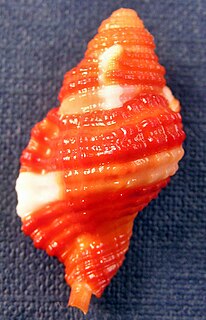
Septa is a genus of small to large predatory sea snails, marine gastropod mollusks in the family Cymatiidae. It was previously considered as a subgenus of Cymatium.
Astrangia solitaria, the dwarf cup coral or southern cup coral, is a species of stony coral in the family Rhizangiidae. It is native to shallow water in the western Atlantic Ocean and the Caribbean Sea.
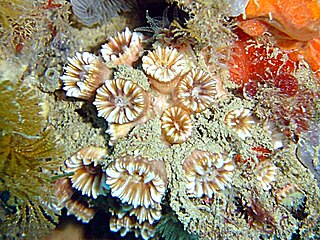
Polycyathus muellerae is a small species of coral in the family Caryophylliidae in the order Scleractinia, the stony corals. It is native to the northeastern Atlantic Ocean and the Mediterranean Sea. It is a large polyp, colonial coral and grows under overhangs and in caves as part of an assemblage of organisms suited to these poorly-lit sites.













